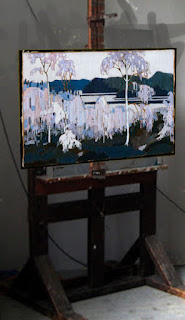 |
| After the Sleet Storm Alternate title: Sleet Storm in the Cedar Bush Winter 1915–16 Oil on canvas 16 1/8 x 22 3/16 in. (40.9 x 56.3 cm) |
The impacts of freezing rain can be quite severe. Any coating of ice on surfaces makes travel extremely hazardous. Freezing rain typically lasts less than two hours but in those rare, extended events, the impacts can be severely extreme. I worked during the lead-up and duration of the Ice Storm of 1998 which has been called "The Worst Natural Disaster in Canadian History". Meteorology could accurately predict the occurrence but not prevent the impacts.
 |
| The Back-lit Singleton Forest illustrates the shimmering ice accumulations similar to those that Tom witnessed |
- the bright sunlight is damaging to your eyes
- the visible side of a backlit subject must be in shadow and lacking in colour and interest
- the painting surface and pallet are probably also in shadow making the colours difficult to discern
Perhaps this is why Tom based this studio work on quick sketches which he saved for some winter day when painting in front of the wood stove would be easier on the eyes and the body. I must also confess to doing the same thing in my Studio Shack more and more now. I am not forty years old anymore...
In any event, Tom was looking southward. The forests on the distant hillsides were all very dark in Tom’s painting. Tom was looking at the shadowed sides of those wintry slopes. The sunlight originated from the far side of the hills and Tom was certainly looking southerly.
 |
Given a southerly perspective, the icy tree tops would be haloed by the backlighting of the sun. From an artist’s perspective, it would have been the only view in order to record the interesting, brilliant light from the ice coating on the trees. The sky, although bright, was overcast with cirrostratus or thin altostratus.
I am crediting Tom with being accurate with the weather even though the canvas was not a plein air creation. Cirrostratus is commonly associated with the warm conveyor belt over the warm sector of a winter storm. The sketches were completed after the freezing rain had ended and the surface warm front had moved northeast of Tom's location. Tom would have been sketching in the warm sector of the storm. Aside from looking into the bright light of the sun, it would have been a very pleasant sketching session.
 |
| Observation of Supercooled water droplets freezing on the windward side of a tree during a freezing rain event |
 |
| Tom sketched looking southerly toward the sun within the warm sector of the winter storm under the cirrostratus skies of the warm conveyor belt (WCB) |
 |
| After the Sleet Storm |
 |
| PowerPoint Slide from "Tom Thomson Was A Weatherman" |
As an aside, “sleet” is an American term for a mix of freezing rain and ice pellets. The term “sleet” is not used by the Meteorological Service of Canada where the phenomenon is referred to as a “mix of freezing rain and ice pellets” (the audience always chuckled at this). The event that Tom recorded was mainly a freezing rain event as ice pellets bounce and cannot stick to surfaces.
Freezing rain is typically associated with a warm or nearly stationary frontal situation. The warm front provides the required layer of above-freezing air aloft. The cold conveyor belt is necessary for the below-freezing temperatures near the surface. If the layer of freezing air is too thick, the melted snowflakes are refrozen into ice pellets (Type A). If the freezing layer is too thin, only the smaller melted snowflakes are chilled enough to become supercooled. Freezing rain requires a Goldilocks cold conveyor belt which is just right - neither too thick nor thin. This makes the accurate prediction of extended periods of freezing rain especially challenging. Doppler and more recently, dual polarization radars have been instrumental in the prediction of freezing rain as well as other precipitation types.
Freezing rain is also more probable with slow-moving weather systems which encourage a vigorous cold conveyor belt (see "Weather Lessons for Everyone from the Cold Conveyor Belt Wizard" for an explanation of why this is true). Slow-moving systems are becoming more common with the climate change weakening of the jet stream. The increased likelihood of split flows also results from the meandering flow of a weaker jet stream. Split flows are very conducive to freezing rain.In addition, cold air often gets trapped at the surface by terrain features which can result in extended periods of freezing rain. The Ottawa River Valley can trap cold air as well as regions north of the Oak Ridges Moraine which includes the Algonquin Highlands. Meteorological friends of mine at Environment Canada produced the accompanying freezing precipitation climatology in the early 1990s before the tragic ice storm of 1998.
 |
| Freezing precipitation in Canada |
 |
View of my Brother's Burritt's Rapids Forest, east of Merrickville, January 1998 |
 |
| Ice Accretions from January 1998 |
Warmest regards and keep your paddle in the water,
Phil Chadwick
PS: It is not coincident that these memories were published in time for early 2023. I remember very well where I was and what I was doing a quarter of a century before.
PSS: Tom Thomson Was A Weatherman - Summary As of Now contains all of the entries to date.









































